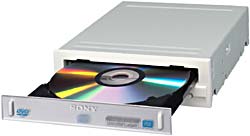 I had a long lunch yesterday with Gordon Kerr, Sony Australia‘s Group Sales and Marketing Manager for Recording Media, Energy and Optical. The main focus was on the new dual layer DVD recording format, but our discussions turned out to be fairly broad ranging.
I had a long lunch yesterday with Gordon Kerr, Sony Australia‘s Group Sales and Marketing Manager for Recording Media, Energy and Optical. The main focus was on the new dual layer DVD recording format, but our discussions turned out to be fairly broad ranging.
The new format, known formally as DVD DL+R, is a write-once disc with two layers, boosting capacity from the existing 4.7GB to 8.5GB. No one reading this needs to be told the benefits this provides. He expects blank media to sell for around $AUS10 each. Sony’s first computer drive (pictured) should be out here around June this year, with a price premium of $100 to $200 above existing drives.
Why is it based on +R? Because the DVD+R and DVD+RW formats are primarily Sony’s and Philips’ babies, and developing a rewritable version is providing difficult technical challenges. Kerr says that the competing DVD-R/RW camp is also experiencing the same problems on their rewritable formats. He expects them to have a dual layer DVD-R out in the near future, though.
Oh, and he says that DVD DL+R recording will work seamlessly across the layer change. That’s a relief.
Why, I asked, do Sony’s consumer DVD recorders support DVD-RW and DVD+RW and DVD-R, but not DVD+R? Copyright, he says. It turns out that while DVD-R and RW have good support for ‘Content Protection for Recordable Media’ (CPRM), and it can be implemented on DVD+RW somewhat, DVD+R does not yet support it. As a major content providing company as well as a consumer electronics manufacturer, Sony is keen to enhance DVD+R to support this as well before whacking it into consumer recorders. CPRM is a system for controlling copying of protected media. It seems to depend on the original recorded material carrying some kind of protection flag, but I have yet to work out fully how it works.
A while back Sony developed a high-capacity CD-R/RW recording technology, allowing up to 1.3GB (about twice CD-R’s capacity) of recording. I asked what was happening with this. He says Sony sold off the technology to another company because it felt (correctly, in my view) that another recordable format would simply confuse the market. The various recordable DVDs do the job quite well enough.
And Blu-ray? How about the DVD Forum’s HD-DVD? Kerr thinks Blu-Ray will win this one. Unlike DVD+/-R/RW there is a signficant compatibility issue between these two high capacity formats. The + and – discs were always physically compatible. Same lasers, same physical organisation of data on the disc surface, and so forth. All they needed for complete compatibility was appropriate firmware to understand their logical idiosyncracies.
But Blu-ray and HD-DVD are not physically compatible. Sure, they use the same 405nm wavelength laser (this is blue in colour, while DVD’s is red — 650nm — thus the name of the former). But there are still huge differences. One obvious one: optical media use the transparent plastic above the data layer as part of the optical system to focus the laser. DVD’s is 0.6mm thick, as is HD-DVD’s. But Blu-ray’s is only 0.1mm thick.
This has other implications. HD-DVD discs are presumably more robust that Blu-ray discs because this layer also has a protective function. But all Blu-ray media are in caddies and so are protected from the casual neglect of their users. If anything the robustness argument favours Blu-ray.
If I had to bet, I’d bet on Blu-ray. It seems to have more industry support. There are actual devices and discs available (at high prices) in Japan. And it offers 27GB rather than HD-DVD’s 20GB on a single layer.
Declaration: In addition to the yummy lunch, I was given at the end the press releases and photos not on the usual CD-R, but on a 128MB Sony Micro Vault USB 2.0 memory thingo — usual price around $120.
